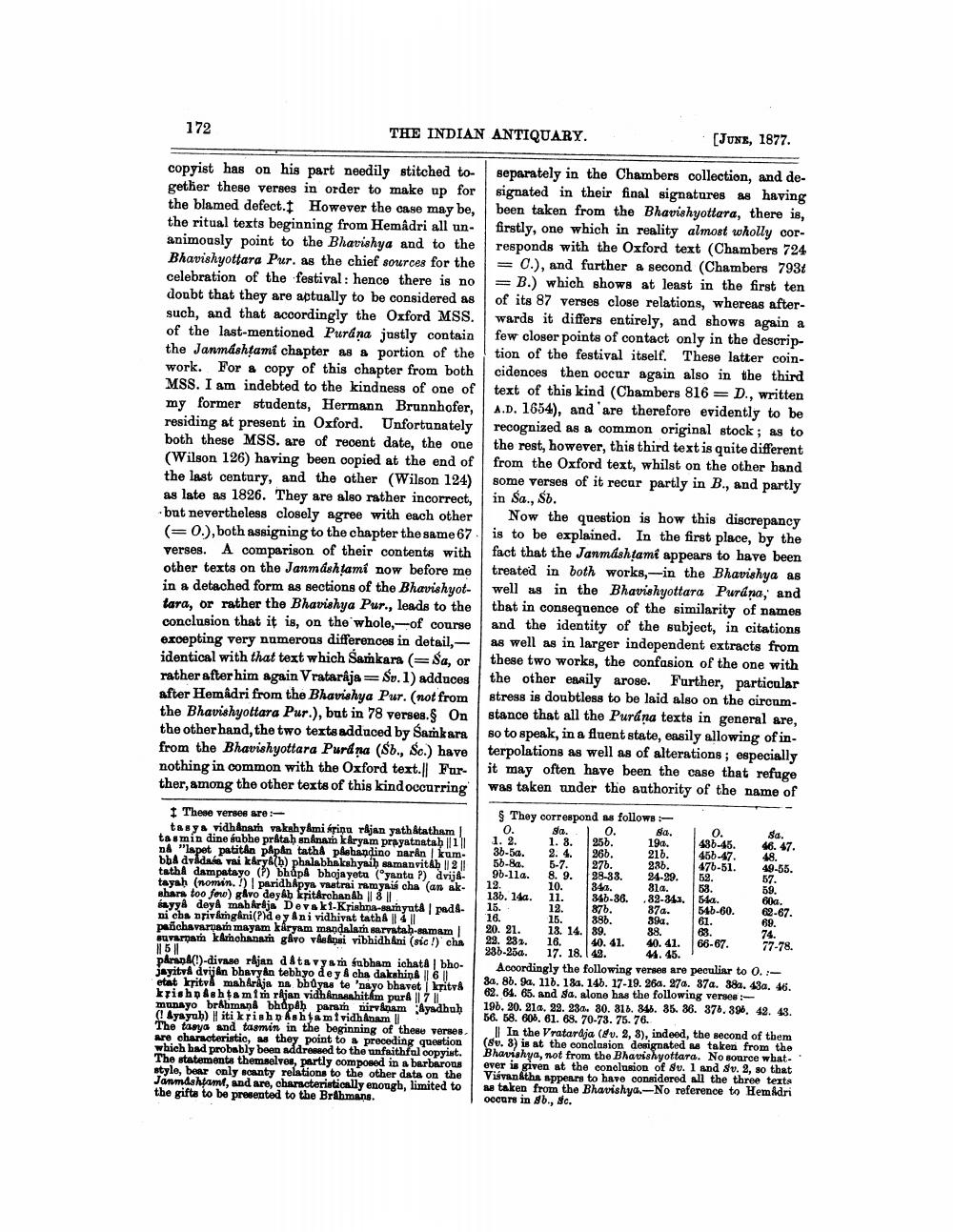________________
172
THE INDIAN ANTIQUARY.
copyist has on his part needily stitched together these verses in order to make up for the blamed defect. However the case may be, the ritual texts beginning from Hemâdri all unanimously point to the Bhavishya and to the Bhavishyottara Pur. as the chief sources for the celebration of the festival: hence there is no doubt that they are actually to be considered as such, and that accordingly the Oxford MSS. of the last-mentioned Purána justly contain the Janmashtami chapter as a portion of the work. For a copy of this chapter from both MSS. I am indebted to the kindness of one of my former students, Hermann Brunnhofer, residing at present in Oxford. Unfortunately both these MSS. are of recent date, the one (Wilson 126) having been copied at the end of the last century, and the other (Wilson 124) as late as 1826. They are also rather incorrect, but nevertheless closely agree with each other (=0.), both assigning to the chapter the same 67 verses. A comparison of their contents with other texts on the Janmashtami now before me in a detached form as sections of the Bhavishyottara, or rather the Bhavishya Pur., leads to the conclusion that it is, on the whole,--of course excepting very numerous differences in detail,identical with that text which Samkara (= Sa, or rather after him again Vrataraja Sv. 1) adduces after Hemâdri from the Bhavishya Pur. (not from the Bhavishyottara Pur.), but in 78 verses.§ On the other hand, the two texts adduced by Samkara from the Bhavishyottara Purána (Sb., Sc.) have nothing in common with the Oxford text.|| Further, among the other texts of this kind occurring
-
=
I These verses are:
tasya vidhanamh vakshyami srinu rajan yathatatham | tasmin dine subhe prâtah snanam karyam prayatnatab ||1|| nå "lapet patitan påpan tatha påshandino narån kum bba dvadas vai kary&(b) phalabhakshyaih samanvit Ah || 2 | tatha dampatayo (?) bhupa bhoja yetu ("yanta ?), dvij tayah (nomin.) | paridhapya vaatrai ramyais cha (an akshara too few) gavo deyab kritarchanah || 8 ||
sayya deya maharaja Devaki-Krishna-samyuta | padani cha nrivámgani(?)dey Ani vidhivat tatha || 4 || pañchavarnam mayam karyam mandalam sarvatah-samam suvarnam kamchanam gavo viensi vibhidhani (sic!) cha 15||
parana()-divase rajan data vyam fubham ichata | bhojayitva dvijân bhavyan tebhyo dey & cha dakshina || 6 etat kritva maharaja na bhúyas te 'nayo bhavet kritvå krishnashtamim rajan vidhanasahitam pura 170 munayo brahmana bhupaḥ param nirvanam Ayadhuh (Ayayah) iti krishnashtami vidhanam
The tasya and tasmin in the beginning of these verses. are characteristic, as they point to a preceding question which had probably been addressed to the unfaithful copyist. The statements themselves, partly composed in a barbarous style, bear only scanty relations to the other data on the Janmashtamt, and are, characteristically enough, limited to the gifts to be presented to the Brahmans.
[JUNE, 1877.
separately in the Chambers collection, and designated in their final signatures as having been taken from the Bhavishyottara, there is, firstly, one which in reality almost wholly corresponds with the Oxford text (Chambers 724 = C.), and further a second (Chambers 793t = B.) which shows at least in the first ten of its 87 verses close relations, whereas afterwards it differs entirely, and shows again a few closer points of contact only in the description of the festival itself. These latter coincidences then occur again also in the third text of this kind (Chambers 816 = D., written A.D. 1654), and are therefore evidently to be recognized as a common original stock; as to the rest, however, this third text is quite different from the Oxford text, whilst on the other hand some verses of it recur partly in B., and partly in Sa., Sb.
Now the question is how this discrepancy is to be explained. In the first place, by the fact that the Janmashtami appears to have been treated in both works,-in the Bhavishya as well as in the Bhavishyottara Purána, and that in consequence of the similarity of names and the identity of the subject, in citations as well as in larger independent extracts from these two works, the confasion of the one with the other easily arose. Further, particular stress is doubtless to be laid also on the circumstance that all the Purána texts in general are, so to speak, in a fluent state, easily allowing of interpolations as well as of alterations; especially it may often have been the case that refuge was taken under the authority of the name of
§ They correspond as follows:
0. 436-45.
19a. 216. 236.
0. 1. 2. 36-5a. 56-8a. 96-11a. 12. 136. 14a. 15.
Sa. 1. 8. 2. 4. 5-7. 8. 9. 10.
ETFLEE
45b-47. 476-51. 24-29. 52.
0. 256. 26b. 276. 28-33. 34. 346-36. 876. 386.
11. 12. 15.
31a. 32-343. 37a. 39a. 38.
53. 54a. 546-60. 61. 63.
16.
20. 21. 22. 237. 236-25a.
13. 14. 39. 16.
40. 41. 66-67.
44.45.
40. 41. 17. 18. 42. Accordingly the following verses are peculiar to 0.:3a. 8b. 9a. 11b. 18a. 14b. 17-19. 26a. 27a. 37a. 38a. 43a. 46. 62. 64. 65. and Sa. alone has the following verses:196. 20. 21a, 22. 23a. 30. 318. 345. 35. 36. 376.396. 42. 43. 56. 58. 60. 61. 68. 70-73. 75. 76.
In the Vratardja (v. 2, 3), indeed, the second of them (Sv. 3) is at the conclusion designated as taken from the Bhavishya, not from the Bhavishyottara. No source whatever is given at the conclusion of Sv. 1 and Sv. 2, so that Viśvanatha appears to have considered all the three texts as taken from the Bhavishya.-No reference to Hemådri occurs in Sb., Sc.
46. 47. 48. 49-55. 57. 59. 60a. 62-67. 69. 74. 77-78.




